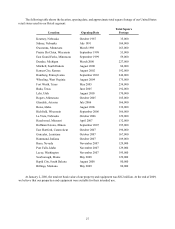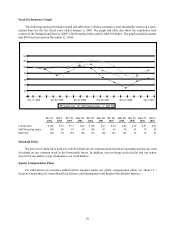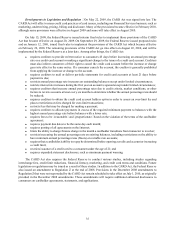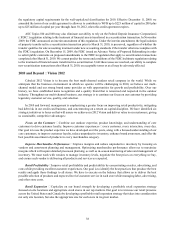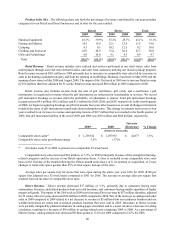Cabela's 2009 Annual Report Download - page 44
Download and view the complete annual report
Please find page 44 of the 2009 Cabela's annual report below. You can navigate through the pages in the report by either clicking on the pages listed below, or by using the keyword search tool below to find specific information within the annual report.35
Developments in Legislation and Regulation – On May 22, 2009, the CARD Act was signed into law. The
CARD Act will affect various credit card practices of card issuers, including our Financial Services business, such as
marketing, underwriting, pricing, billing and disclosure. Many of the provisions became effective in February 2010,
although some provisions were effective in August 2009 and some will take effect in August 2010.
On July 15, 2009, the Federal Reserve issued interim final rules to implement those provisions of the CARD
Act that became effective on August 20, 2009. On September 29, 2009, the Federal Reserve issued proposed rules
and on January 12, 2010, issued final rules to implement the provisions of the CARD Act which became effective
on February 22, 2010. The remaining provisions of the CARD Act go into effect on August 22, 2010, and will be
implemented by the Federal Reserve at a later date. Among other things, the CARD Act:
• requires creditors to provide written notice to consumers 45 days before increasing an annual percentage
rate on a credit card account or making a significant change to the terms of a credit card account. Creditors
must also inform consumers of their right to cancel the credit card account before the increase or change
goes into effect in the same notice. If a consumer cancels the account, the creditor is generally prohibited
from applying the increase or change to the account.
• requires creditors to mail or deliver periodic statements for credit card accounts at least 21 days before
payment is due;
• restricts annual percentage rate increases on outstanding balances except under limited circumstances;
• restricts interest rate increases during the first year an account is opened except under limited circumstances;
• requires creditors that increase annual percentage rates due to credit criteria, market conditions, or other
factors to review accounts at least every six months to determine whether the annual percentage rate should
be reduced;
• requires creditors to obtain the credit card account holders opt-in in order to assess an over-limit fee and
places restrictions on fees charged for over-limit transactions;
• restricts fees that may be charged for making a payment;
• requires creditors to allocate payments in excess of the required minimum payment to balances with the
highest annual percentage rate before balances with a lower rate;
• requires fees to be “reasonable” and “proportionate” based on the violation of the terms of the cardholder
agreement;
• requires payment due dates to be the same day each month;
• requires posting of all agreements on the Internet;
• limits the ability to charge finance charge in the month a cardholder transitions from transactor to revolver;
• restricts increasing the annual percentage rate on existing balances, including restrictions on the ability to
have minimum annual percentage rates (floors) on variable rate accounts;
• requires that a cardholder’s ability to repay be determined before opening a credit card account or increasing
a credit limit;
• restricts issuance of a credit card to a consumer under the age of 21; and
• requires expanded statement disclosures, such as minimum payment warning.
The CARD Act also requires the Federal Reserve to conduct various studies, including studies regarding
interchange fees, credit limit reductions, financial literacy, marketing, and credit card terms and conditions. Future
legislation or regulations may be issued as a result of these studies. In addition to the CARD Act, the Federal Reserve
also issued an amendment to Regulation Z at the end of 2008. Provisions in the December 2008 amendments to
Regulation Z that were not superseded by the CARD Act remain scheduled to take effect on July 1, 2010, as originally
provided in the December 2008 amendments. These amendments will require additional enhanced disclosures to
consumers on cardholder agreements, statements, and applications.




